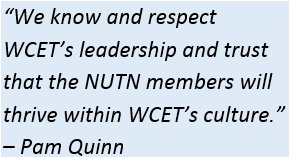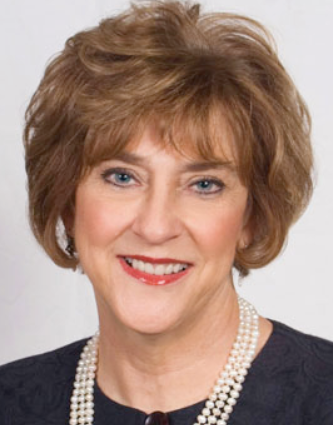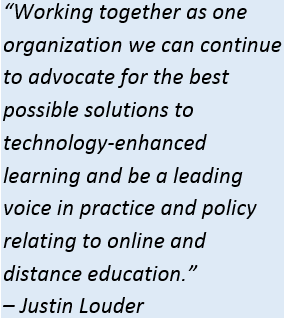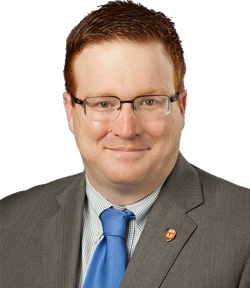As NUTN Transitions into WCET - A Look Back and to the Future
Published by: WCET | 9/12/2018
Tags: Distance Education, Leadership, WCET, WCET Annual Meeting
Published by: WCET | 9/12/2018
Tags: Distance Education, Leadership, WCET, WCET Annual Meeting
NUTN, the National University Technology Network, is a consortium of higher education institutions that just celebrated its 35th anniversary. As of September 1, NUTN is now incorporated into WCET. We welcome our new friends and are glad to have them on board. In today’s post we look back at the history of NUTN and at what lies ahead in this expanding new relationship with WCET.
Joining us in this conversation are three NUTN leaders giving us different perspectives on the organization:
 Q: Pam, let’s start with you. You have been active with NUTN throughout its history, could you tell us about the early days and the driving forces behind creating this organization?
Q: Pam, let’s start with you. You have been active with NUTN throughout its history, could you tell us about the early days and the driving forces behind creating this organization?
A: NUTN has been an acronym for the National University Technology Network, but when it was founded, the “T” stood for Teleconferencing network. Founded by JO Grantham of Oklahoma State University, the first conference was held in the spring of 1983 at the Hyatt in Kansas City, MO. Grantham and other advocates and university users of satellite teleconferencing for teaching, assembled a group of over 50 participants to help improve the way we could teach with satellites but also to share each other’s teleconferences when the subject matter was applicable.

I was early in my career when I attended that first conference and knew nothing about how satellites worked. Grantham got up in front of the attendees drawing a picture of a satellite uplink dish on a flip chart on one side of the room. He then ran with his arms pointing up into the air at an imaginary satellite in the sky across the room to another flip chart where he drew a rudimentary farm house where the signal was downlinked. His visual and physical demonstration (sans PPT or video) was extremely effective, and everyone in the room immediately understood what he was talking about.
Of the 50 people in attendance, Russ Adkins and Fred Hurst, both from Wichita State at the time and Ronda Edwards, then from East Lansing CC, were the only other people that I still know today. NUTN grew from that first meeting into a thriving consortium of colleges and universities who together pioneered the use of satellite teleconferencing as viable way to teach students at a distance across state lines with one-way video and two-way audio.
Q: Pam, what were some of the successful activities and events that mark NUTN’s history?
A: As one of the first consortiums using technology to teach, NUTN was all about sharing ideas that worked and developing best practices. NUTN grew to over 200 institutions that included community colleges but was primarily attracting land-grant universities who were developing distance education programs as part of their Continuing Education outreach mission. NUTN worked with vendors as well as institutions to find new ways to reach students who couldn’t or wouldn’t come to a campus. Vendors and educators sat side-by-side on the board with one goal in common: to effectively use technology to teach and learn at a distance.

Although technology continually changed, NUTN’s conferences remained a constant since 1983. The 35 annual meetings moved around the country to attract both current and new users of satellite teleconferencing. When the NUTN Board realized that the technology that was above the ground, like ITFS and satellites, was all moving under the ground, like cable and the internet, NUTN changed to stay current. Like most consortiums that were founded around a certain technology, we all ended up using the internet and the National University Technology Network became known for smaller conferences focusing on leadership in distance education. One of the most successful conferences was held in Kennebunkport when NUTN began focusing on the importance of quality in online learning. This was before any other group made “quality” their focus. NUTN was always looking for ways to share best practices to improve distance learning for faculty and students everywhere.
NUTN also began recognizing leaders at all levels that were promoting ways to serve distance students. The person to first receive the annual NUTN Distinguished Service Award was Governor Michael Leavitt of Utah in 1998 who was one of the two founding governors of Western Governors University. Gov. Leavitt attended our meeting in Vail that year and talked about the reason he and Governor Roy Romer of Colorado believed strongly in finding new ways to get more adult students through the pipeline. They championed WGU as this new kind of university and worked to get it approved by four different accrediting agencies, a feat that few, if any other university, has achieved. NUTN’s recognition of pioneering educators, technology developers, thought leaders, and politicians helped build and strengthen the field of distance learning that we know today.
Q: Robert, could you talk about the rich relationships you created and some of the more memorable experiences?
The core of NUTN has always been relationships. My first NUTN conference was in San Antonio in 2003. I was invited to be on a panel facilitated by Dr. Gary Woods, then head of voluntary education at the Department of Defense. I went to the conference knowing no one in advance. Not only did I leave as a volunteer on the marketing committee, but I met a number of outgoing individuals that I still interact with today. The forming of new connections and strengthening of old ones has never stopped. I’ve interacted with and been inspired by DL professionals from all kinds of institutions and from all over the world. I’ve even had the opportunity to visit many NUTN members schools all over the US and Canada.

The countryside surrounding Memorial University and College of the North Atlantic (both in Newfoundland, Canada) is some of the most breathtaking I’ve ever seen. The great folks at Savannah College of Art and Design rolled out the red carpet for us in 2015 for a one of a kind experience.
Probably the event I remember the most was the awards luncheon during our 2008 conference in Park City, Utah. The luncheon was scheduled at the hotel’s ski lodge at the top of the mountain. We were to take the high-speed gondolas over the treetops and ravines and up to the event. Keeping in mind that back in 2008 we still held a summer conference, as we were to head up to the lodge it started to snow. We had a great awards ceremony including a keynote by our Distinguished Service Award recipient, Dr. Gary Allen, looking out over the snowfall. As we readied to make our descent, the sun broke through the clouds and it was green grass and summer temperatures by the time we reached the base of the mountain.
Q: Justin, you are a more recent addition to the NUTN family and chaired the Advisory Committee. Could you share about some of the issues that were addressed in NUTN meetings or projects that you found particularly helpful to the community?
I think what drew me and Texas Tech to NUTN, along with many others, was the networking aspect of the organization. Coming together as a board, or as the larger organization allowed for opportunities to sit and talk with others in similar roles all over the US and Canada. I think as a board we never wanted someone to feel isolated at our events or meetings; you wanted to hear from all sides to discuss issues schools were dealing with online or technology-assisted education.

Over the last few years, as NUTN was working on reinventing itself, we tried to do smaller events focused on one topic so everyone could dig into the issue. We did a highly successful daylong event (in partnership with WCET) on accreditation and how distance and online education impacts an institutions overall regional accreditation. We had speakers from most of the regional accreditors, legal scholars, and speakers from both public and private, for-profit institutions. We came together as a community of educators to discuss how we needed to prepare for and work with accreditation for online/distance ed.
Another event that I am particularly proud of was a summit we had on Open Educational Resources before many professional organizations in the online/distance ed space talked about OER. Once again, NUTN was able to bring together experts from across the nation together to talk about how faculty utilizes OER resources, how institutions could implement OER initiatives, and what copyright or legal issues you might face.
NUTN events covered hot topic issues that schools and institutions were dealing with, problems that might not have been included at other conferences or by other organizations. Because NUTN was a nimble organization, we could pivot and talk about what our schools were dealing with quickly and try to produce materials or opportunities for a discussion around the issue to help our members resolve whatever was going on.
Q: Each of you and the Board were instrumental in negotiating this new arrangement with WCET. Why WCET?
Pam: Through the 35 years since NUTN was founded, members have always been extremely loyal to the organization. In fact, most people joined NUTN not just because of what they learned, but because of the network of colleagues they formed. In our field with most of us not having institutional leadership who studied or understood distance learning and teaching with technology, the network of colleagues was critical for personal support and development. Since Justin Louder and I had both served as NUTN chairs and also on WCET’s committees, we knew that the culture and commitment of WCET was close to what NUTN’s has been. It was important for the NUTN board to pursue a good match for the members, and WCET was the best solution. We know and respect WCET’s leadership and trust that the NUTN members will thrive within WCET’s culture.
Justin: As the NUTN board looked at what the next phase for NUTN would be the board had to decide if NUTN would disband or somehow merge with another organization so that the NUTN spirit could survive. The board made the decision that NUTN needed to merge with another organization aimed at enhancing educational technology and education in general. WCET is an outstanding organization, one whose mission is very near to NUTNs, we wanted our members to have the opportunity to be a part of an organization that valued networking and the collegiality just as much as NUTN did.
Q: Looking forward, what do you hope to see from this transition of NUTN being integrated into WCET?
Pam: The field of distance learning is no longer marginal. It is mainstream education. With the trend of continuous growth in online learning over the past 20 years, it will be important for those who have studied and advocated for online learning to continue to have a voice. Many IT professionals think they developed online because it has involved computers and digital technology. However, the real developers are those who have worked tirelessly for years to make distance and online education at least as good or better than traditional classroom education. With the research and advocacy of the WCET leadership, this provides the continuing foundation for online to continue to grow and excel as it serves more and more students each year. With former NUTN members working side by side with the excellent work of WCET and its members, this strengthens the field and provides the successful platform necessary for the future. 
Justin: NUTN was one of the first organizations in the technology-enhanced space, and over the course of NUTNs thirty-five-year existence it was one of the leading organizations talking about everything from telecourses to adaptive courseware, we talked about copyright, how to serve our students and teachers, so they felt connected to the institution. I think these discussions will continue with WCET and its membership because as Pam said, distance learning is no longer marginal, it is a crucial component to most institutions of higher education because our students and faculty expect to be able to learn or teach anytime and from any place. Working together as one organization we can continue to advocate for the best possible solutions to technology-enhanced learning and be a leading voice in practice and policy relating to online and distance education.
Robert: I hope that NUTN’s members, current and past and along with the WCET, can continue to lead the way to innovation in higher education. Working together is the best way to put students first.
Q: Any last thoughts or wisdom to share?
Pam: Having been heavily involved in distance learning throughout my career, from telecourses to cable, to satellites and to the internet, I’ve worked with faculty and students as we’ve all pioneered new ways to teach and learn.
I’ve been dedicated to this field for 36 years, and I’m excited about the future. However, it is essential that we continually research and discover the best ways to serve students with whatever technology comes next. Those students working remotely need the special student services to make enrolling and registering easy. They need the courses and the faculty to engage them so that they are retained.
With distance learning students sometimes feeling isolated or disconnected, we must continue to develop the institutional support that recognizes their needs and serves them as best as we can. As I just recently moved into the phase I prefer to call rewirement, I remain an advocate for doing things right. Keep up the good work, WCET and all its members. Students depend on your focus, dedication, and leadership.
Thank you, Pam, Justin, and Robert, for sharing your history and your hopes for the transition.
We also appreciate your leadership and patience as we worked through this transition. You should be proud that we have made it to this next phase.

Russ
Russell Poulin
Director of Policy & Analysis
WCET – WICHE Cooperative for Educational Technologies
rpoulin@wiche.edu
@russpoulin

1 reply on “As NUTN Transitions into WCET – A Look Back and to the Future”
Having been involved with NUTN early on I can say it was for me any my institution an important and supportive group. The early days of online education were exciting and the opportunity to meet and discuss challenges with colleagues was always a valued aspect of the NUTN conference. Congratulations Pam on your retirement and thank you, and your team, for the positive leadership and support you provided. I know the spirit of NUTN will live on in WCET.
With thanks,
Bill
William Seaton
Provost
Thomas Edison State University
Trenton, NJ